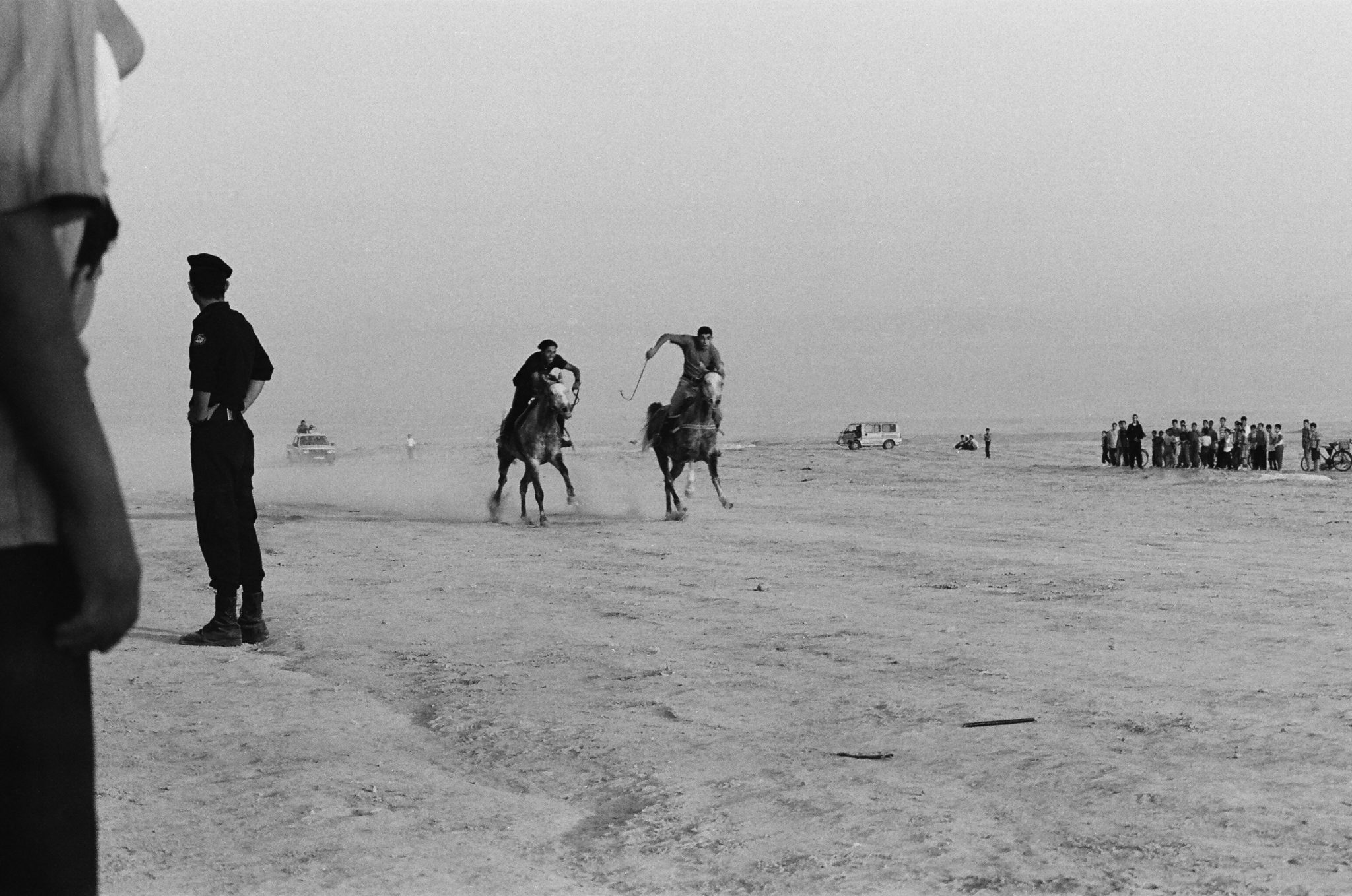What is an image of Palestine? What can any image say about a continuous history of occupation, violence, identity and displacement?
Back in 2019, Palestinian Jewish theorist and filmmaker Ariella Aïsha Azoulay proposed that we might usefully think about imperial violence in terms of the action of a camera shutter. ‘This brief operation can transform an individual rooted in her life-world into a refugee, a looted object into a work of art, a whole shared world into a thing of the past,’ she writes in Potential History: Unlearning Imperialism. She is thinking here of how technologies of knowledge production – imaging, naming, categorising, interpreting – can and were used to render colonial violence invisible in archives. It is not necessarily the camera itself that is always an apparatus of violence, but, elsewhere in her book, Azoulay reminds us that the camera often ‘made visible and acceptable imperial world destruction and legitimated the world’s reconstruction on empire’s terms’.
Between that ‘individual rooted in her life-world’, and the frozen, photographic image of her, is an act of translation. Those dynamic social practices that sustain her life-world are translated into frozen, empirical facts ready to be classified, documented and displayed by an expert – be they historian, academic, journalist, curator or NGO worker – ‘who at best may not share in that same life-world, and at worst is trained to ignore or belittle what stands in the way of imperial violence. Moreover, because that world can be presented as ‘a thing of the past’, given that the action of the camera’s shutter can only capture what is the past once that action is over, the photograph wields the power to imply that the worlds that empire destroyed were already things of the past. But to reject this narrative, Azoulay proposes, is always possible. Nothing about the operation of a shutter can ever again appear neutral or independent of its outcome when we aspire, instead, to witness ‘for and with others targeted by imperial violence’. The Palestinian photographer Ahlam Shibli’s genre-spanning works can be understood as an exercise in doing just that.
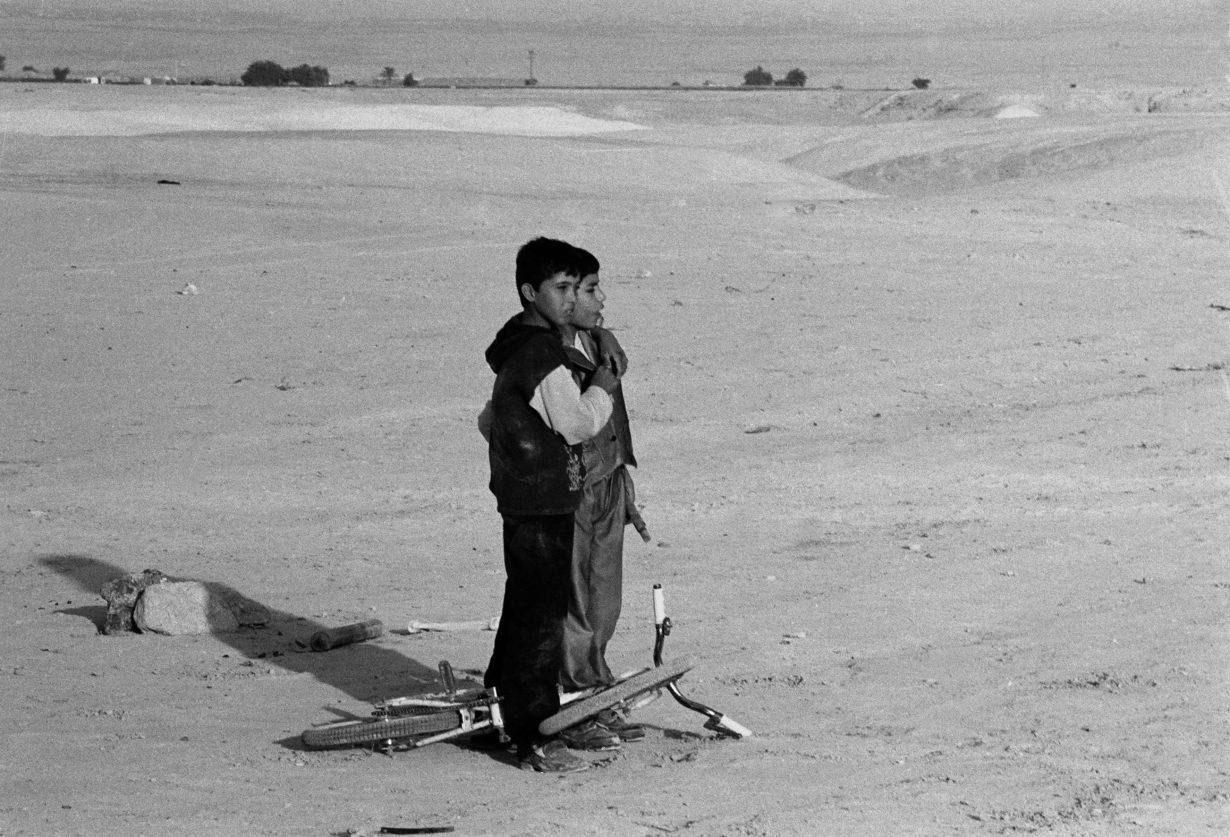
Born in Shibli-Umm al-Ghanam, Palestine, in 1970, Shibli is an artist who works with lens-based mediums. Best known for her photography (though also a filmmaker), Shibli operates an aesthetic that has often been associated with the documentary style. Her close attention to the living conditions, social histories and environments of Palestinian communities can certainly merit the label, but the socio-political inflections of the word ‘documentary’ sit uneasily with the ways in which Shibli handles themes such as occupation, violence, home, identity and displacement. Even her earliest images, like the series of six black-and-white photographs from 1997 titled Horse Race in Jericho, evoke no sense of a documentarian’s eye behind the lens. Although Shibli’s use of space, light, shape and texture shows a formal expertise in her chosen medium, her eye is never that of one who stands apart from their subject. For example, in the third image from Horse Race in Jericho, two racers are pictured in full gallop from a child’s eye-level. This unusual compositional choice seems to place the photographer alongside the two Palestinian boys watching the action in the first image of the series: one has the protective arm of an older brother around the other, and they look to the riders in awe. This sense of being a participant, rather than an observer, is also reinforced by the second image of the series. There, Shibli turns her back to the fierce Jericho sun to deliberately cast her own shadow on the sands; torso bent, her left elbow pointing skywards to steady her shot, the photographer’s corporeal presence turns her into a participant-spectator of the cultural practice, and the bonds it forges between landscape, animal and human.

Art that speaks of emplacement, participation and commitment is a conscious and powerful representational choice when we speak of a people and a place marked by 76 years of dispossession, erasure and displacement. Indeed, online biographies and exhibition brochures abound with the claim that Shibli is above all a photographer who destabilises the concept of home and identity. Perhaps the implication is that, given the extraordinary conditions of Palestinian life, Shibli is interested in the many processes people undertake, within and without, to create a makeshift sense of home – whether via rituals, objects or words. For example, in the 24-colour-photograph series Unrecognised (1999–2000), homemaking in the Bedouin village of ‘Arab al-N’aim looks like the children’s drawings on the corrugated iron exteriors of homes, and the traditionally hand-embroidered shirts women wear. In Arab al-Sbaih, a 2007 series of 47 images about Palestinian refugees in Jordan, it is in the carefully preserved family albums, and the talk of elders. But it may be equally true to say Shibli captures how a home under occupation must cease being a place and become a process. Discussing nation-building after colonialism in The Wretched of the Earth (1961), Frantz Fanon warns that ‘nation’ – the collective home that is to be built in the image of its people, not in that of their coloniser – must be a verb, not a noun. It is not found in ‘the flag and the palace where sits the government’, he writes, but in the ‘coherent, enlightened action’ of people working ‘to create a prospect that is human’.
While place never ceases to be vitally important to the Palestinian condition, when a home is made unhomely through either unceasing violence (for those who stayed) or the pain of exile (for those who left), it must, and does, transform into a collective activity. Shibli’s series of 72 colour and black-and-white photographs titled Positioning (1997–2002) is a striking record of what this may look like. The series features differently lit and composed photos that suggest some geographical distance between shots. ‘Home’ could be found in the traditional wedding celebrations of a young couple, or in the Palestinian food an elderly woman is dishing out of a large cooking pot. Home could be his goat to a young Palestinian boy in yet another image, or in the young men dancing the dabke with keffiyeh tied to their waists. These all capture a diverse community keeping their cultural life-world alive.
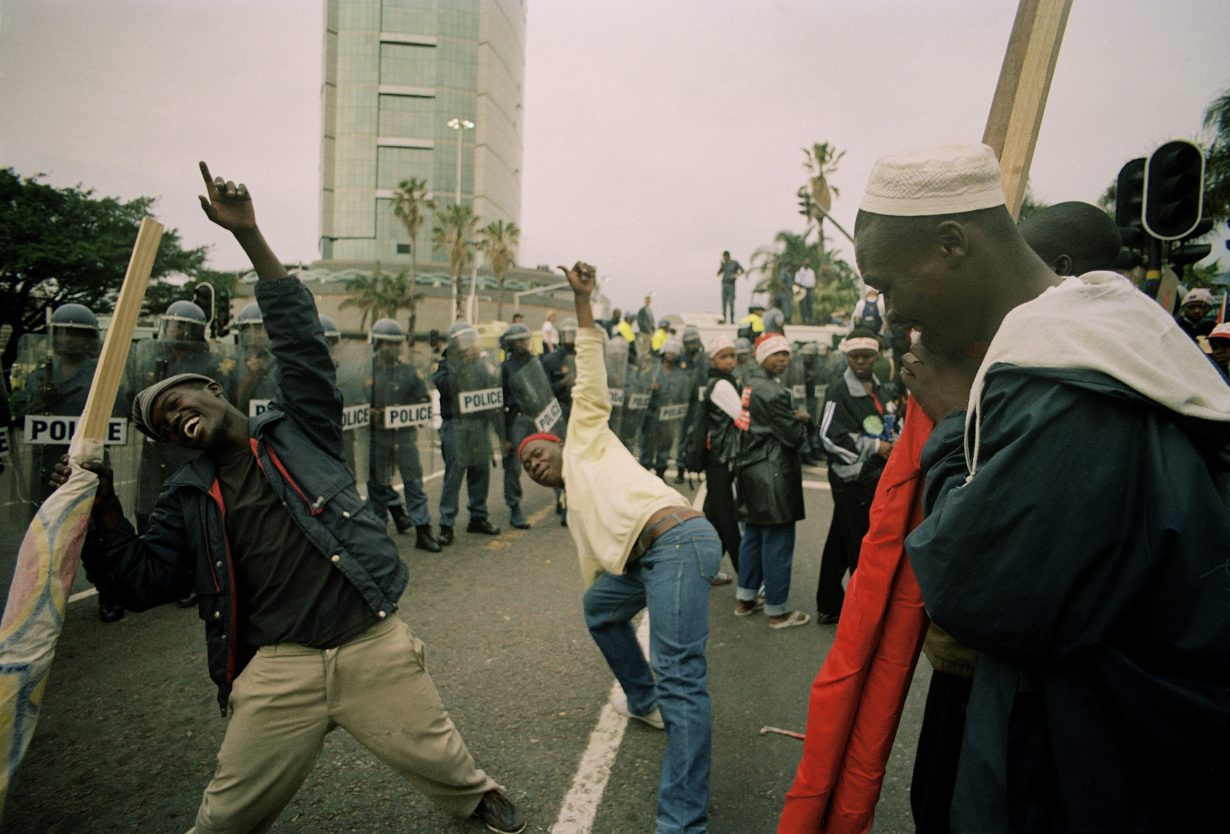
Included among these are photos that remind the viewer this life-world has long been under siege. Dynamic, almost photojournalistic images, both in colour and black-and-white, show worldwide demonstrations in support of Palestine over three decades. These overwhelmingly feature people of the Global South: Brazilian crowds unfurl a banner that reads ‘All Support for the Intifada’ in Portuguese; an African-American man runs past a KFC with a placard that reads ‘Free Our Brothers & Sisters!’ Exemplary of Shibli’s preference for a sequence of witnessed moments instead of composed, individual photographs, Positioning captures a world that positions its struggles adjacent to those of Palestinians.
In this sense, while not all of Shibli’s works are about her homeland, her entire oeuvre is nevertheless underpinned by a transformation from spectating-observing to connecting-witnessing for and with others. This also extends to minority communities in a series titled Eastern LGBT (2004/06), which challenges the Orientalist lens (a whole host of visual, cultural and spatial mythologies around Arabs and Asians that served the interests of colonialism). Far from depicting lives lived in a state of fear, exclusion and danger – the narrative often imagined in the West – Shibli’s camera instead roves around dressing rooms and backstage areas to capture both collectively charged and tenderly intimate moments. In one image, placards that read ‘Proud to Be Queer and Muslim’ are readied for a march; in others, we see queer folks enjoy solo moments of self-admiration in front of a mirror, and drag queens do each other’s makeup.
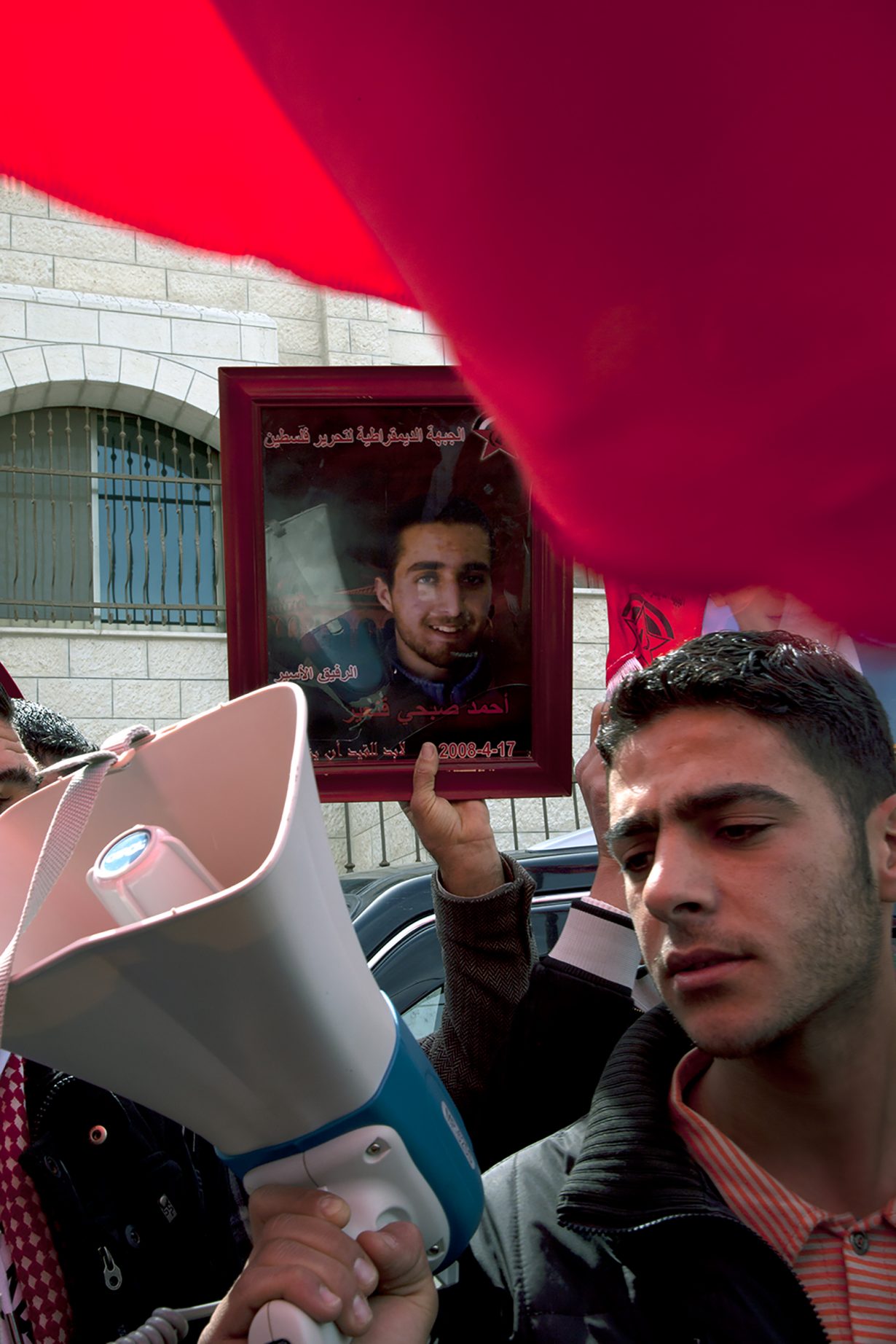
On 6 September 2023, almost exactly a month before Hamas launched a surprise attack on Israel from Gaza – and Israel retaliated on a scale that has led to allegations of genocide currently under consideration at the International Court of Justice – Shibli’s photographic series Death (2011–12) was presented at the 35th Bienal de São Paulo. (Her more recent Occupation, 2016–17, is also about the destruction of Palestinian livelihoods, this time in Al-Khalil/Hebron, while her series Heimat, 2016–17, is another interrogation of the idea of ‘home’, but within the context of German Gastarbeiter, ‘guest workers’.) In resurrecting her older series Death at São Paulo, Shibli may seem to have had a disconcerting premonition – over the next seven months over 35,000 Palestinians were killed, including over 15,000 infants and children. But if it is foremost death that the occupier has brought upon this land, it is perhaps unsurprising, following the arguments set out above, that the main preoccupation of Shibli’s Death series is life.
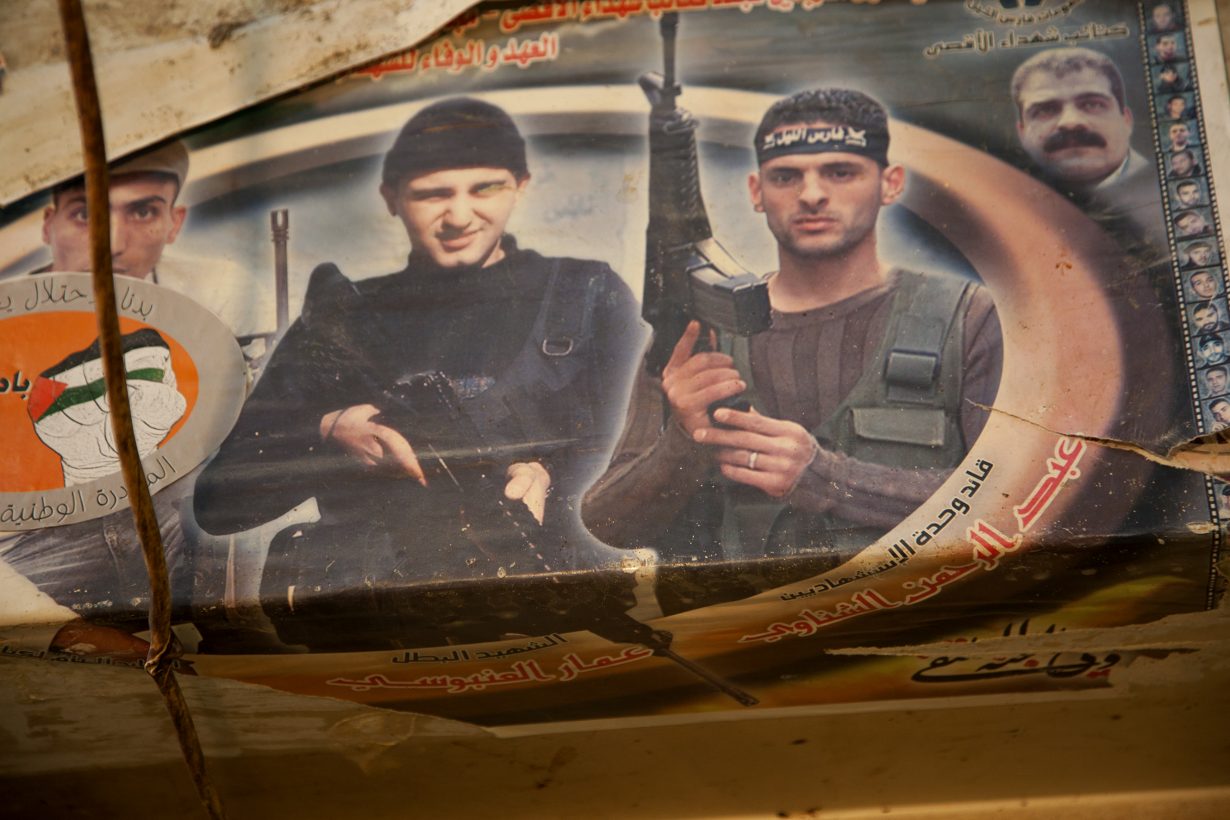
in Nablus. The poster carries a sticker showing a raised fist with the Palestinian colors and reading, “We want the occupation to lose. Boycott Tapuzina [an Israeli soft drink]. Palestinian National Initiative.”’ © and courtesy the artist
Comprising 68 photographs, it explores mnemonic and commemorative practices around Palestinian martyrdom in the city of Nablus in the West Bank. The location of Death is deliberate; Nablus was one bastion of resistance during the Second Intifada (2000–05), for which it was kept under curfew for over a record-breaking 100 days. Palestinian resistance has taken many forms since the 1948 Nakba: violent, nonviolent; religious, secular; spontaneous, strategic. Death focuses on the one constant in this history: martyrdom, which is here culturally understood as a death caused by the occupation, whether directly or indirectly. Unlike the demands of photojournalism, which must find and verify cause and effect, Shibli asks her viewer to start (perhaps uncomfortably) by accepting that the lived experiences of Palestinians are justification enough for using the term to describe many manner of deaths. In several images, young men idle at the entrance of a graveyard in Balata refugee camp, watched over by commemorative posters of their fallen friends. Inside, verdantly green tombs feature stones that bear portraits of their inhabitants as they were in life: often young men, proudly posing with an automatic rifle – either in front of a cheap studio background, or alongside digitally superimposed faces and lettering that commemorates a relative whose example they followed to martyrdom. In yet other shots, the faces of young men (and some women) are displayed on rugs, posters, walls and lockets; they are carefully dusted and polished by family members in the certainty that the dead, too, will surely see the coming of freedom.
Shibli’s choice of the term martyr is deliberate, requesting, in her 2013 essay titled ‘The Truth in My Photographs’, our participation in calling for ‘the end of a situation that breeds “martyrs”; it requests the end of occupation’. The Arabic word for martyr, shaheed, can also mean ‘witness’, depending on the context. Shibli’s lens points to where those contexts bitterly continue to be one and the same.
A retrospective of Ahlam Shibli’s photographic work, Dissonant Belonging, is on view at luma Westbau, Zürich, through 8 September
Sarah Jilani is a lecturer in postcolonial literatures and world film at City, University of London
